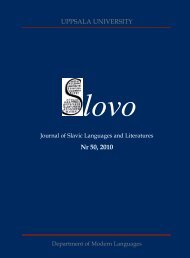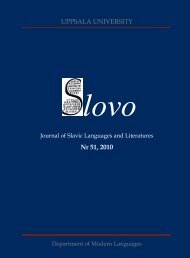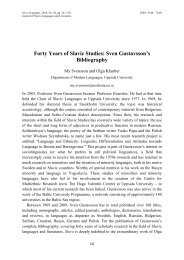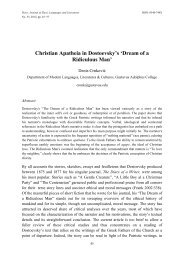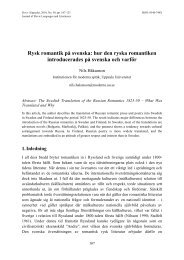Full text PDF - Index of - Uppsala universitet
Full text PDF - Index of - Uppsala universitet
Full text PDF - Index of - Uppsala universitet
You also want an ePaper? Increase the reach of your titles
YUMPU automatically turns print PDFs into web optimized ePapers that Google loves.
Slovo.<br />
Journal <strong>of</strong> Slavic Languages and Literatures<br />
(1) Всё, бывало, с ней через забор разговариваю и под конец, чтобы<br />
недалеко было ходить, сделал я в заборе калиточку. (Anton Čechov,<br />
“Baby”)<br />
(2) I used always to be talking to her across the fence, and in the end I made a<br />
little gate in the fence so as not to have to go so far round.<br />
(3) Jeg pleide å snakke med henne over gjerdet, og til slutt – for at det ikke skulle<br />
være så langt å gå – laget jeg en liten port i gjerdet. (Norwegian)<br />
More specifically, the present tense in the embedded verbs follows from a licensing<br />
condition which allows present tense morphology in Russian when the verb is<br />
semantically tenseless. A verb is semantically tenseless if its time argument (reference<br />
time) is abstracted away. This implies that the verb must get its temporal interpretation<br />
from some other operator which controls the reference time <strong>of</strong> the embedded verb. In<br />
the Russian construction above, this operator is the habitual verbal quantifier byvalo,<br />
which corresponds to used to / pleide å in English and Norwegian.<br />
The present study is based on authentic data from parallel corpora, notably the<br />
multilingual RuN-Euro parallel corpus that has been compiled at the University <strong>of</strong><br />
Oslo. The authentic data with parallel translations (mostly <strong>of</strong> Russian originals) will<br />
allow us to contrast the Russian constructions with the use <strong>of</strong> verbal quantifiers in<br />
Germanic languages and to keep track <strong>of</strong> relevant aspectual and temporal phenomena<br />
in the Slavic and Germanic data.<br />
2. Verbal quantifiers and the SOT parameter<br />
In Slavic languages aspect obviously plays the role <strong>of</strong> the defining verbal category. In<br />
Germanic languages, on the other hand, the tense system contains a rich inventory <strong>of</strong><br />
auxiliaries and composite past and future tenses. Auxiliaries are temporal quantifiers,<br />
but they also come with their own verbal morphology. We thus define a broader<br />
category <strong>of</strong> verbal quantifiers:<br />
A verb v is a verbal quantifier if and only if<br />
(i) v can be inflected with uninterpretable tense morphology (v has its own verbal<br />
morphology)<br />
(ii) v controls the reference time <strong>of</strong> the embedded verb (v is a temporal quantifier).<br />
Here are some verbal quantifiers in English and Russian: 3<br />
says [un], said [up], will [un], would [up], has [un], had [up]<br />
govorit [un], govoril [up], budet [un]<br />
3 [un] = uninterpretable present (now), [up] = uninterpretable past, i.e. features like [un] and [up] simply indicate<br />
the morphology <strong>of</strong> the verb and point to the presence <strong>of</strong> a corresponding operator, [in] (interpretable now) and<br />
[ip] (interpretable past), respectively. In addition comes the semantic contribution <strong>of</strong> the verbal quantifier itself.<br />
64



